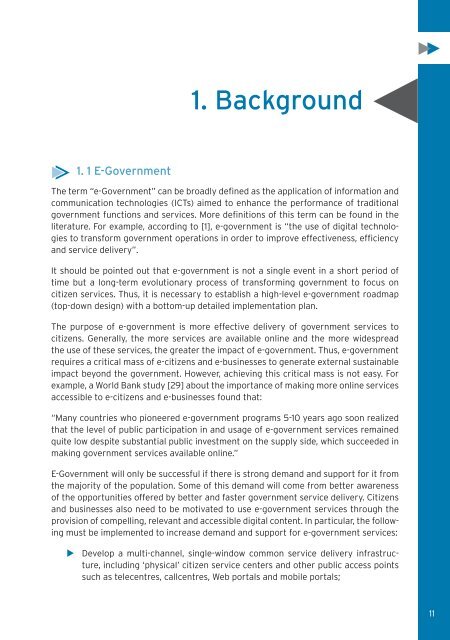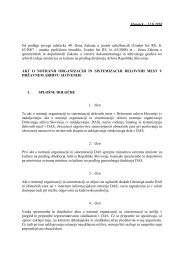for Local Governments
for Local Governments
for Local Governments
You also want an ePaper? Increase the reach of your titles
YUMPU automatically turns print PDFs into web optimized ePapers that Google loves.
1. 1 E-Government<br />
1. Background<br />
The term “e-Government” can be broadly defined as the application of in<strong>for</strong>mation and<br />
communication technologies (ICTs) aimed to enhance the per<strong>for</strong>mance of traditional<br />
government functions and services. More definitions of this term can be found in the<br />
literature. For example, according to [1], e-government is “the use of digital technologies<br />
to trans<strong>for</strong>m government operations in order to improve effectiveness, efficiency<br />
and service delivery”.<br />
It should be pointed out that e-government is not a single event in a short period of<br />
time but a long-term evolutionary process of trans<strong>for</strong>ming government to focus on<br />
citizen services. Thus, it is necessary to establish a high-level e-government roadmap<br />
(top-down design) with a bottom-up detailed implementation plan.<br />
The purpose of e-government is more effective delivery of government services to<br />
citizens. Generally, the more services are available online and the more widespread<br />
the use of these services, the greater the impact of e-government. Thus, e-government<br />
requires a critical mass of e-citizens and e-businesses to generate external sustainable<br />
impact beyond the government. However, achieving this critical mass is not easy. For<br />
example, a World Bank study [29] about the importance of making more online services<br />
accessible to e-citizens and e-businesses found that:<br />
“Many countries who pioneered e-government programs 5-10 years ago soon realized<br />
that the level of public participation in and usage of e-government services remained<br />
quite low despite substantial public investment on the supply side, which succeeded in<br />
making government services available online.”<br />
E-Government will only be successful if there is strong demand and support <strong>for</strong> it from<br />
the majority of the population. Some of this demand will come from better awareness<br />
of the opportunities offered by better and faster government service delivery. Citizens<br />
and businesses also need to be motivated to use e-government services through the<br />
provision of compelling, relevant and accessible digital content. In particular, the following<br />
must be implemented to increase demand and support <strong>for</strong> e-government services:<br />
� Develop a multi-channel, single-window common service delivery infrastructure,<br />
including ‘physical’ citizen service centers and other public access points<br />
such as telecentres, callcentres, Web portals and mobile portals;<br />
11

















